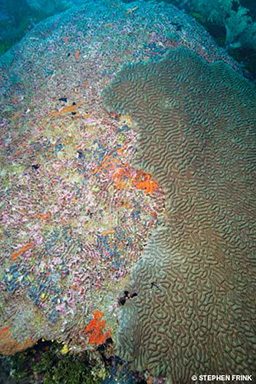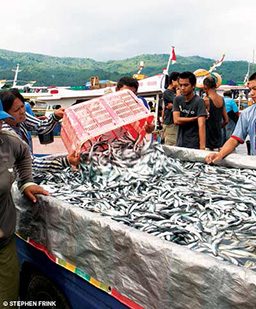Think back to your first dive on a coral reef. Remember the clear, turquoise water and the fields of multicolored, intertwining branches or massive mounds that were home to a never-ending ballet of bright, tropical fish and a host of other unforgettable creatures. For many divers, these are memories of days gone by; healthy reefs are becoming rarer each year.
Coral reefs are among the most biologically diverse and economically valuable ecosystems on earth. They offer unmatched beauty while protecting shorelines and providing hundreds of billions of dollars worth of food, jobs and recreation. For centuries, many tropical island and coastal cultures have depended on coral reefs for sustenance and livelihoods.

Divers make pilgrimages to experience the wonders of reefs, seeking adventures and encounters with nature. But we see the changes taking place in the undersea world. Many coral reefs are bleached or disappearing, and the species that depend on them are dwindling.
Broad protections for reefs have been in effect for years. The National Oceanic and Atmospheric Administration (NOAA), along with other federal and state agencies as well as industry and conservation groups, work alongside ocean users to protect reefs. Although these efforts have resulted in many successes, corals are still at risk. In an effort to confront the challenges that threaten corals with extinction, NOAA’s National Marine Fisheries Service (NOAA Fisheries) is now proposing new protections for many coral species under the Endangered Species Act (ESA).
In 2009 the Center for Biological Diversity petitioned NOAA Fisheries to list 83 species of reef-building corals. The agency determined 82 of those species merited further consideration for listing and convened seven expert federal scientists to evaluate the status of each species, reviewing threats, vulnerability and risk of extinction. Additionally, a management group evaluated existing regulations and conservation actions that provide protection for these corals. In December 2012, NOAA Fisheries proposed listing 66 of those species under the ESA. A final determination is due in December 2013.
Threats
Two broad categories that encompass the most severe problems reefs face are greenhouse gases and local threats. In 2010 the experts assembled by NOAA Fisheries identified ocean warming, disease and ocean acidification as the most influential risks to extinction of coral species by the year 2100. They also identified several local threats that are common to coral populations in many different places. Of these, sedimentation, nutrient enrichment and overfishing were considered of medium risk for driving corals to extinction by 2100. Other threats such as collection and trade, physical damage and outbreaks of invasive species or coral predators are also harmful to corals but generally only at local levels, and these can be managed with existing laws.
Let’s examine the big three.
Ocean warming and ocean acidification. These two global threats are very different but share the same cause: rising levels of carbon dioxide (CO2), the most significant greenhouse gas in Earth’s atmosphere. Activities such as the burning of fossil fuels, cement production and the clearing of forests drive this threat.
Rising CO2 in the atmosphere has changed the planet’s climate and warmed the ocean, causing corals to expel the microscopic algae from their cells, which leads to coral bleaching and death. Severe bleaching destroyed 19 percent of the world’s reefs between 1997 and 1999, and more corals died during a second worldwide mass bleaching in 2010. Regional events caused local losses, including a loss of more than 60 percent of the coral in the U.S. Virgin Islands during a 2005 Caribbean mass-bleaching event.
Rising CO2 is also entering the ocean, dropping the pH and depriving corals of the carbonate ions they need to build their calcium-carbonate skeletons. This one-two punch slows coral growth and recovery, kills corals and makes reefs erode faster than we’ve ever seen.
Coral disease. Coral disease is becoming more common because of warming ocean waters and pollutants flowing onto reefs. Researchers in Florida found that corals caught diseases from human sewage dumped into the ocean. Unfortunately, the causes of most coral diseases remain unidentified.
Protective Measures
Hundreds of laws protect corals and coral reefs worldwide. In the United States, more than 80 regulations protect corals directly or indirectly. It is illegal, for example, to collect live stony corals without a permit in every coral-bearing state and territory. Laws in Florida and Hawaii prohibit damaging corals as well. Thousands of marine protected areas (MPAs) throughout the world also provide varying degrees of protection for corals.

If corals are listed under the ESA, federal agencies would be required to help conserve these species. Additionally, these agencies would be required to evaluate potential impacts of projects they authorize, fund or carry out and consult with NOAA Fisheries to ensure they do not jeopardize listed coral species or damage coral-reef habitats. In addition, NOAA Fisheries would develop recovery plans — road maps for resource managers, landowners, fishermen and others to use to promote the recovery of listed corals.
ESA prohibitions against “take” (harm, collection, damage, killing or attempts to do these) would immediately apply to any corals listed as endangered in the U.S. and its territories. A separate rule prohibiting take would be required for species listed as threatened. NOAA’s Office of Law Enforcement along with cooperating law-enforcement agencies would be responsible for carrying out these rules with the goal of preventing extinction and helping listed corals recover. Divers who have a “look but don’t touch” mentality have nothing to fear and everything to gain from these protections.
Coral reefs are declining rapidly. We have already lost more than 20 percent of the world’s reefs and will likely lose another 35 percent in the next few decades. It is clear we value these ecosystems. To ensure they’re still around for future generations, we must reduce the greenhouse gases that are warming and acidifying the ocean and reduce stressors such as pollution, habitat degradation and destructive fishing practices that damage reefs locally. Both these steps are necessary to protect corals, and you can help.
What Can You Do?
- When diving, practice good buoyancy control, and avoid contact with corals.
- When boating, use mooring buoys, or anchor well away from live corals.
- When fishing, keep gear and lines away from corals.
- When dining, choose sustainable seafood, and avoid key grazers such as parrotfish.
- When traveling, use carbon offsets to reduce the impact of aviation.
- Conserve energy and water.
- Make sure your sewage is properly treated.
- Avoid using fertilizers, pesticides and other chemicals that can run off into local waterways and the ocean.
© Alert Diver — Q2 Spring 2013